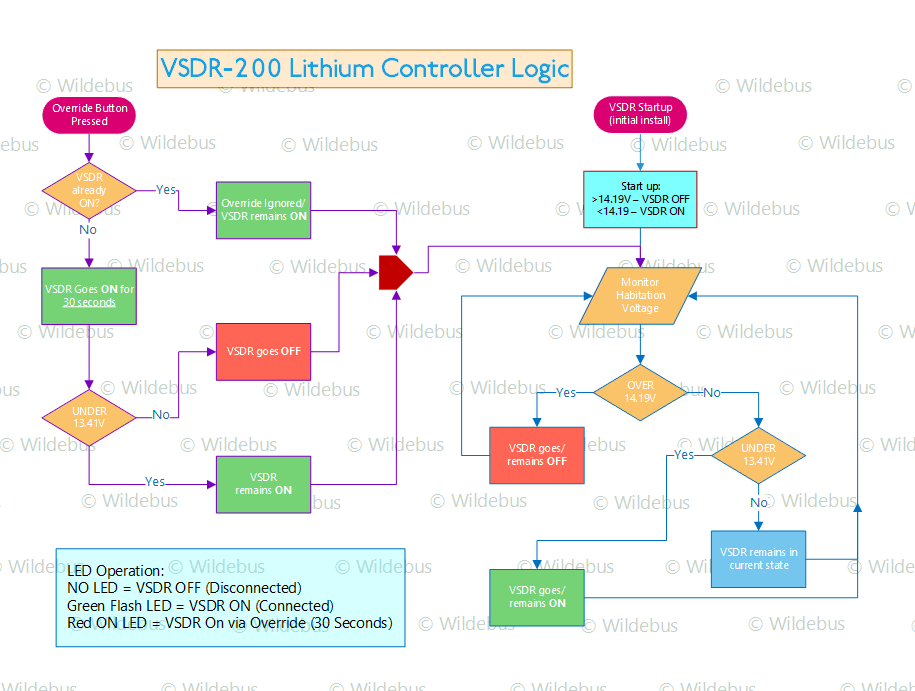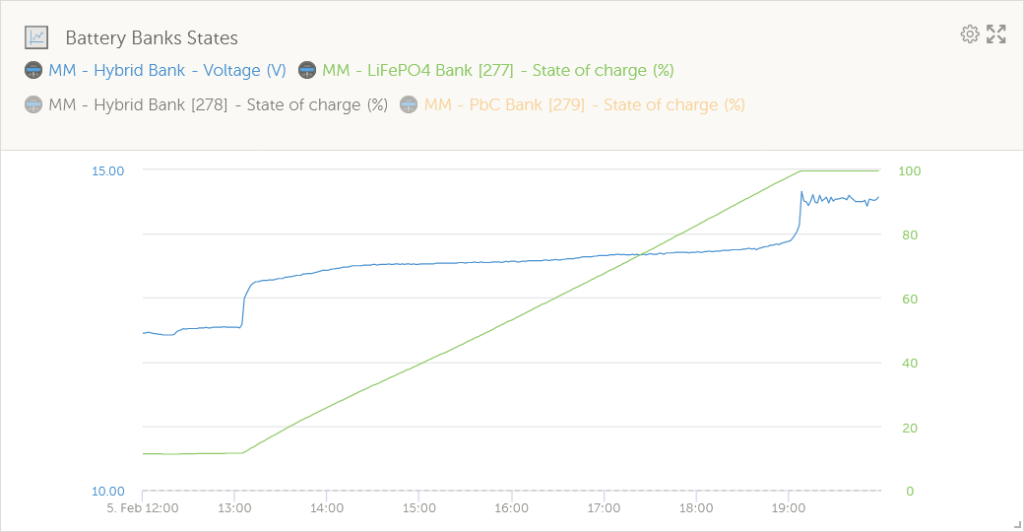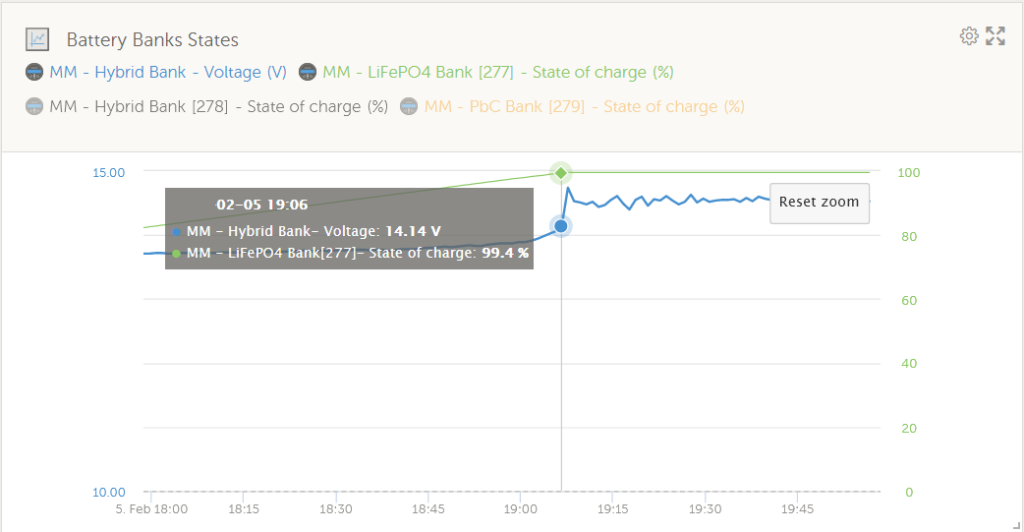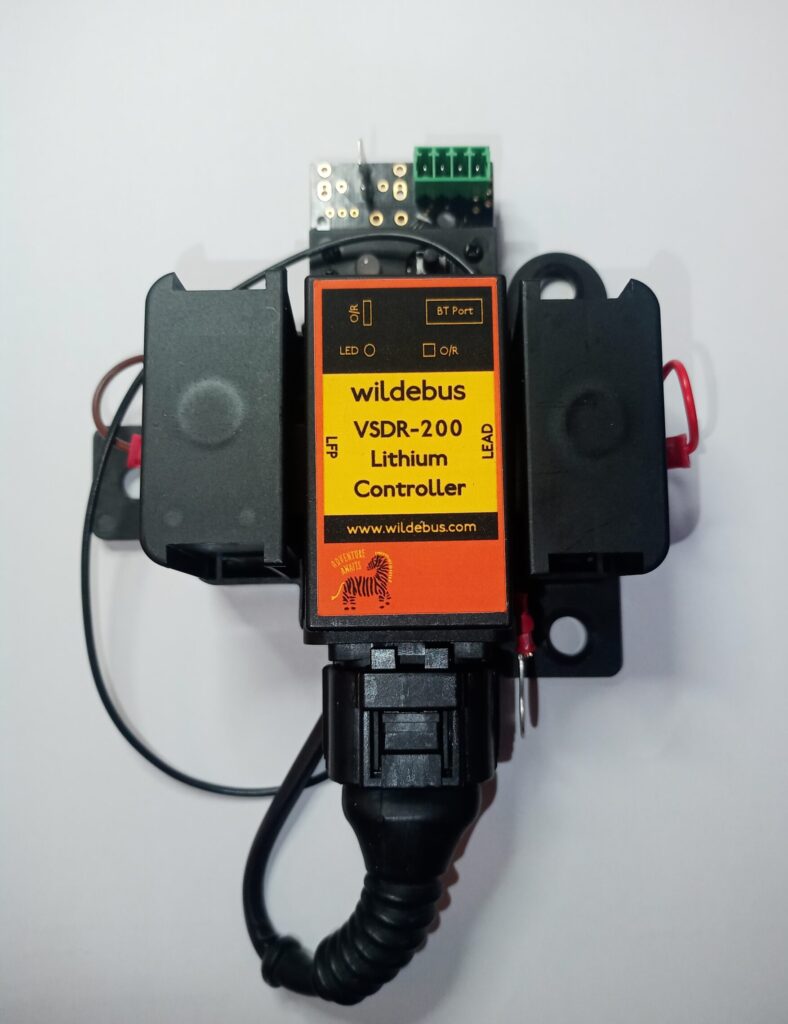VSDR Lithium Controller Information
Previously ….
“Lithium Batteries and Lead Acid have different charging requirements and characteristics, so how does it work with Lead and Lithium cabled together?
The typical LiFePO4 battery is quoted as wanting a charge voltage around 14.2V and a float of around 13.6V is quoted (different manufacturers will specify their own parameters, but those are pretty typical). The Typical Lead Acid wants around 14.4V to 14.7V and a float around 13.8V – so you can see a gap there.”
Please Note: The content here is provided as general advice and information and is not specific to YOU or YOUR vehicle.
It should be used at your risk, is not warranted or guaranteed in any way and we are not liable for any losses or damage that might occur.
If this is not acceptable to you and you do not agree to this, do not read any further.
VSDR-200 Lithium Controller
Addressing how to manage batteries connected in parallel but needing different charging requirements and profiles is why I created the VSDR-200 Lithium Controller
It is a special Microprocessor-based Control Device that is not dependant on, and will work independently from, any Monitors, but can still apply the above Voltage Logic to automatically disconnect and reconnect the LiFePO4 Lithium Battery as required. This device includes a latching relay which means very minimal current consumption in either on or off state.
Please note: We recommend and only support the use of LiFePO4/LFP Batteries with the VSDR Lithium Controller. Other Lithium-Ion types of Battery are not recommended for use in Recreational Vehicles and Craft as Leisure/Habitation Batteries.
VSDR Specification
The VSDR Lithium Controller incorporates a 200A continuous rating 1500A intermittent load switching relay. The standard VSDR is a 12V model, but we can provide a 24V version on request. The VSDR draws less than 2mA in standby mode and as the Relay unit are latching there is negligible battery drain whether the relay is open or closed. This means minimal power use whether the Lithium Battery Bank is connected or not.
VSDR-200 Lithium Controller (12V Version)
| Item | Value |
|---|---|
| Isolation | Non-Isolated |
| Nominal Operating Voltage | 12V DC (10V – 15V) |
| Relay Through-Current | 200A Continuous; 1500A 1 second |
| No Load Current | <2mA |
| Operating Temperature | Min -30C; Max 70C |
| Size/Weight | 145mm x 110mm x 45 (L x W x H); 400g |
| Connections | 8mm Posts |
Physical Layout

Installation
Installation of the VSDR is very simple. Install in a suitable location for the size of the VSDR (see table and diagram above).
Use 8mm Lugs to connect the LEAD and the LITHIUM Battery leads to the VSDR posts and connect the black lead -VE 8mm ring terminal to a suitable common ground.
There should be Fuse Protection on the cable between the Lead Battery/Habitation System and the VSDR Lithium Controller, same as when adding any device into a system. This should be sized suitably for the Load/Charge expected between the Lithium Battery Bank and the Lead/Hab system and no more than the Ampacity of the cable used.
How it works
The VSDR works on Voltage as stated above. It monitors the Voltage of the Habitation Electrics (which include the Lead Battery bank) constantly through a very accurate bit of electrical wizardry.
The Unit is programmed to react in a certain pattern based on readings and existing settings. The flowchart below shows the logic for the 12V VSDR; With the 24V version, the voltages noted would simply be doubled.

Regular operation is shown on the right. On the left you can see how the Override may interrupt the flow for upto 30 seconds before the normal programmed process takes over.
Why 14.19V as a disconnection voltage?
Now it is widely understood – and I agree with this – that you cannot tell the state of charge of an LFP battery by its voltage. So how can we use a voltage to determine when a Lithium Battery no longer needs charge?
Now I have found on careful monitoring over a period of time that this is really only the case when the battery is in use. When a Lithium Battery is being charged, the voltage increase is very linear, matching the SOC increase, and as the battery starts to reach full capacity, the voltage then starts to increase more rapidly, but still in a predicable linear fashion.
See below a graph of a LiFePO4 Lithium Battery charging from around 10% SOC to full. The Green Line is the Batteries State of Charge (SOC) and you see how that is a straight line as the charger is putting out a constant current and the battery is taking it all.

You see on the graph above how the Voltage (blue) line is pretty straight, just showing a gradual incline? This is typical of the LiFePO4 Battery, and then as the battery reaches near full SOC, the voltage really starts to ramp up.
The following graph drills down in more detail to that time, showing how the voltage relates to the State of Charge of the Battery. I have hovered over the graph to show how the Voltage correlates to the SOC when close to full.

The Victron Monitoring system I am using samples the data once per minute. You see that by 19:06 the SOC is 99.4% and the voltage is 14.14V? At this point, the VSDR Lithium Controller is still on (it switches off at 14.19V) and the battery is just about full (0.6% off). by the next data poll at 19:07, the VSDR has switch off as the voltage goes over 14.19V (and you see a little spike which is normal when a load is removed) and the battery is now at 99.6% SOC. So the logic of using a VOLTAGE to control a Lithium Charger actually works very well.
This pattern above is totally consistent and one I have noted from the very beginning of the Hybrid Battery project – and which allowed me to come up with the VSDR design, negating the need to have expensive SOC Monitoring and complex Shunt arrangements. (The only reason I have all the extra monitoring here to compare Voltages with SOC values, etc, is to confirm the operations are just as they should be. They are not needed in any way for the VSDR to operate).
Why 13.41V as a reconnection voltage?
OK, so that is why we have 14.19V for turning the VSDR Off. But why 13.41V before it goes back on?
The Resting Voltage of a 12V LiFePO4 Lithium Battery is around 13.3V. A Battery Charger, once it has finished the Absorption Stage of charging a Lead Acid battery and goes into float is around 13.7V (different manufacturers quote different numbers for their batteries, but it is in the range of 13.6V to 13.8V).
By not reconnecting the VSDR until 13.41V, you are keeping the Lithium Battery from having a constant voltage from a charger presented to it. Lead Acid Batteries can benefit from having a float or slightly lower storage voltage on them once fully charged; Lithium Batteries absolutely do not.
If your Charger remains active (EHU/Shore power plugged in, for example), the Lithium stays disconnected and if you are using the 12V habitation electrics system, you will be actually using power from the charger rather than the battery.
Then on disconnecting the charger, as soon as you continue to use the 12V system, the surface charge that Lead Batteries have after a charge is wiped out and the voltage starts to drop down to ~12.8V (a fully charged Lead Acid Battery is around 12.7V-12.9V). As the voltage drops, as soon as it goes below 13.41V the VSDR comes on again and the Lithium Batteries start to provide the power. And they stay connected until you charge the batteries sufficiently for the voltage to rise to 14.2V again. This is the operational cycle that you can see in the flowchart shown earlier on.
No Float on the Lithium Batteries?
Disconnecting at 13.4V eliminates the float voltage being presented to the LFP.
But I said right at the start “The typical LiFePO4 battery is quoted as wanting a charge voltage around 14.2V and a float of around 13.6V is quoted (different manufacturers will specify their own parameters, but those are pretty typical).” A Contradiction?
Well, yes and no. The manufacturers of Lithium Batteries like to promote their batteries as “Drop In Replacements” so you can use your existing chargers with adjusting the settings. But there are very few chargers where you can program it to set a Bulk/Absoption Voltage and no Float Voltage. So you see a ‘safe’ Float Voltage quoted. It won’t really do any harm to the Lithium Batteries, but they would usually prefer not to be maintained at float. And that is our default position on the VSDR.
However, if you had a reason or a preference to maintain a Float Voltage onto a Lithium Battery, that is also very easily done with a VSDR Lithium Controller. You would change the Reconnection Voltage from 13.41V to a higher setting – below the charge voltage but greater than the Float Voltage and that is all that is needed. To make this change, you would request this configuration change at the time of purchase prior to dispatch; or you could send the VSDR back to us to be reprogrammed. Both services are Free of Charge and you would just pay the postage costs if sending your unit back for reprogramming.
Availability of the VSDR
The VSDR Lithium Controller comes ready programmed with the various voltage thresholds required. The defaults are 14.19V for the Disconnect Voltage and 13.41V for the Reconnection Voltages. These can be altered on request prior to shipping.
The VSDR-200 Lithium Controller is now shipping and we have sent these within the UK and Worldwide for both RV and Marine users, shipping throughout Europe, into the USA, to the Far East and to Australia and New Zealand.

VSDR-200 Lithium Controller
Our latest version of the VSDR-200 has a connection for external override of the VSDR for enhanced control, including if there is any need to use Battery SOC or voltage parameters should the user have a BMV-700, BMV-702 or BMV-712 Monitor on their LiFePO4 bank and wants even greater flexibility for such situations as running a top-down balance on DIY LiFePO4 Battery Banks.

6 responses to “Hybrid Battery Bank – VSDR Lithium Controller”
I have 2 12V lead acid deep cycle in series to feed a 24V trolling motor on a fishing boat. I would like to augment the batteries with 1 (24V) or 2 (12V) LiFePo4 batteries. Does your device make this possible? Thank You!
Hi Chris,
Thanks for your Question.
You would need the 24V version of course, but I see no reason why you could not this. As far as the trolling motor is concerned, it would just appear as you had a larger battery bank.
I don’t know enough about trolling motors on boats to know if there is any benefit to Lithium or not other than the usual Lithium benefits (greater use of given capacity and faster charge rates, for example).
I am looking at a solution like this for an off grid house situation with 48v x 400 Ah (4s2p AGM 3 years old) batteries and currently, a Victron EasySolar II GX controller. It needs more of everything and I have a larger solar inverter and more panels on order, but don’t yet have a good solution to increasing the battery capacity.
Do you have a 48 V model?
That is one big Battery Bank! Sorry, only 12V and 24V.
Hi David
I have a Dutch barge with 24v lead battery banks ,starter and leisure ,I have a sterling split charger from the alternator and solar panels and controller and victron 16a charger,I’m very interested in adding lithium to my leisure bank and really like the look of your vsdr lithium controller will it work with alternator charging or do I need additional kit/ protection .Thanks for your enthusiasm on this subject
Cheers Dave
Hi Dave,
Sounds great!
When adding Lithium to an existing Lead Battery Bank and using the VSDR Controller, both battery banks will use the same chargers as you already had and you keep them set to the same charging profile as before (this is the beauty of the VSDR Lithium Controller)
I am assuming your Sterling Split Charger is a Battery-to-Battery (B2B) Charger and not just a relay device? It is important to have some kind of Current Limiting device on the alternator to Lithium Battery as Lithium Batteries have such low resistance, they can really load an alternator to its limits – and beyond! One of the features of a B2B is the fact it does current limiting, so you are ok in that respect.
Given you are adding more battery capacity, you could consider a larger/additional B2B to give faster charging if your Alternator is suitable to take more load without harm?
HTH,
David